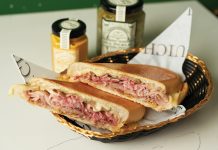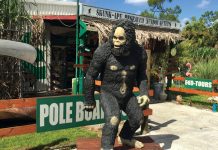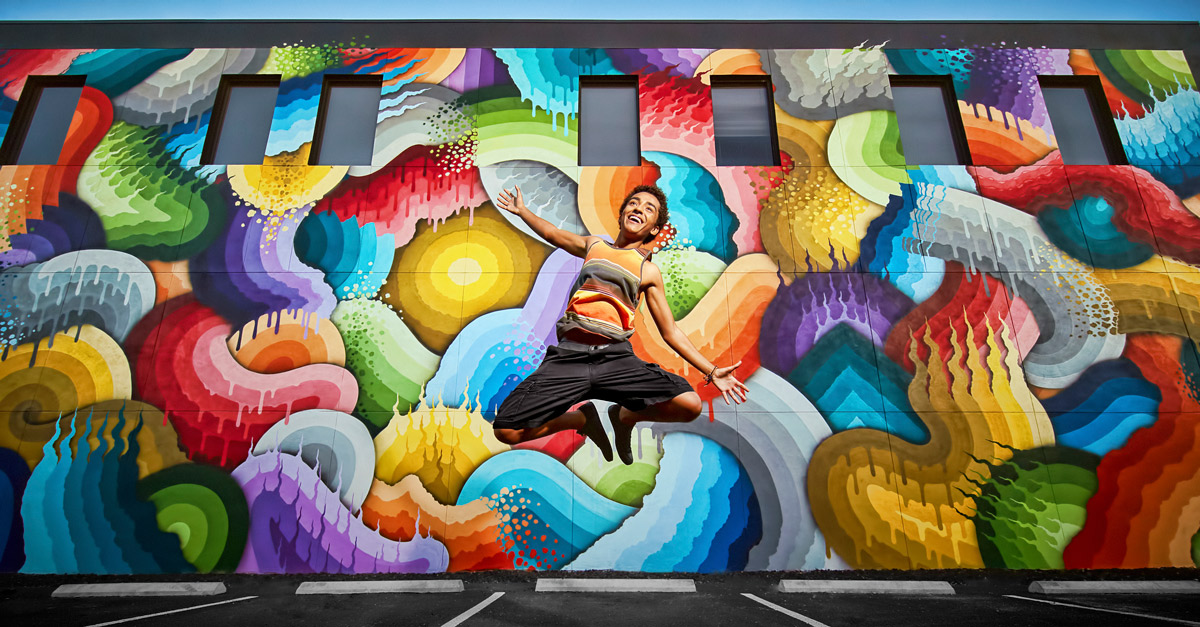
“Five years ago, none of this was here,” artist Derek Donnelly says as we wander through the brick-paved alleyway that runs behind the 600 block of Central Avenue in downtown St. Petersburg. He’s not referring to the buildings, some of which date to the early 1900s, but to the arresting murals splashed across their backsides.
Pause in front of one wall, and you’re confronted with the heavy-lidded eyes of Twiggy, her unblinking face stamped against a pastel background. A few feet away, the jaws of a menacing blood-red shark hover inches above a metal gate. (“That’s a popular spot for selfies,” Donnelly says.) At the end of the alleyway, on a short tunnel between two buildings, a mural shows a gray-haired granny grinding a skateboard down a beachfront sidewalk—Donnelly’s own send-up of St. Petersburg’s longtime reputation as a retiree mecca.

Photograph courtesy of the City of St. Petersburg
It wasn’t so long ago that older people were just about all that St. Petersburg—jokingly nicknamed “God’s Waiting Room”—was known for. Marketed as a retirement haven after World War II, the city drew countless old-timers looking to trade frigid northern climes for warm ocean breezes and a spot on one of downtown’s famous green benches.
Today, those old benches are gone, as is the geriatric vibe. Instead of elderly residents, a young, hip, creative crowd has taken over St. Petersburg. In fact, the most visible population in this city of a quarter-million people is artists like Donnelly.
“It’s been a sea change,” says John Collins, founding executive director of the St. Petersburg Arts Alliance, a nonprofit dedicated to arts advocacy and fundraising. “The number of performers, writers, and visual artists who have moved to this area has increased by more than fifty percent in ten years. We’ve found ourselves with one of the largest concentrations of artists in the Southeast.”
The evidence is visible far beyond spray-painted building facades. The city has amassed enough galleries and museums to fill dozens of city blocks, helping turn neglected neighborhoods into thriving, vibrant spaces. St. Petersburg boasts the largest collection of Salvador Dali works outside Spain, as well as the Morean Arts Center’s Chihuly Collection, dedicated to the works of renowned glass artist Dale Chihuly. It’s also home to seven distinct arts districts—areas densely packed with galleries, museums, studios, and theaters.
“St. Petersburg is a great walking city, but it used to be that you didn’t really want to walk through these empty stretches of downtown,” Collins says. “Now you can walk down Central Avenue, which runs from Tampa Bay to the Gulf of Mexico, and spend all Saturday poking in art studios, watching art being made, and taking a mural tour.”
St. Petersburg’s new age as an arts hub is only beginning. The Imagine Museum, devoted to the studio glass movement of the 1960s through today, recently opened. And the city has two more major art institutions under construction: the James Museum of Western and Wildlife Art, featuring a sculpture court and a wide-ranging collection of Native American jewelry, and the Museum of the American Arts and Crafts Movement, showcasing decorative and fine arts pieces from the likes of Gustav Stickley and Frank Lloyd Wright.
“Every city has that period when it’s special, when creativity and opportunity collide,” says Bob Devin Jones, artistic director of the Studio@620, a community space that hosts a variety of performing and visual arts events. “Right now, that’s St. Pete.”
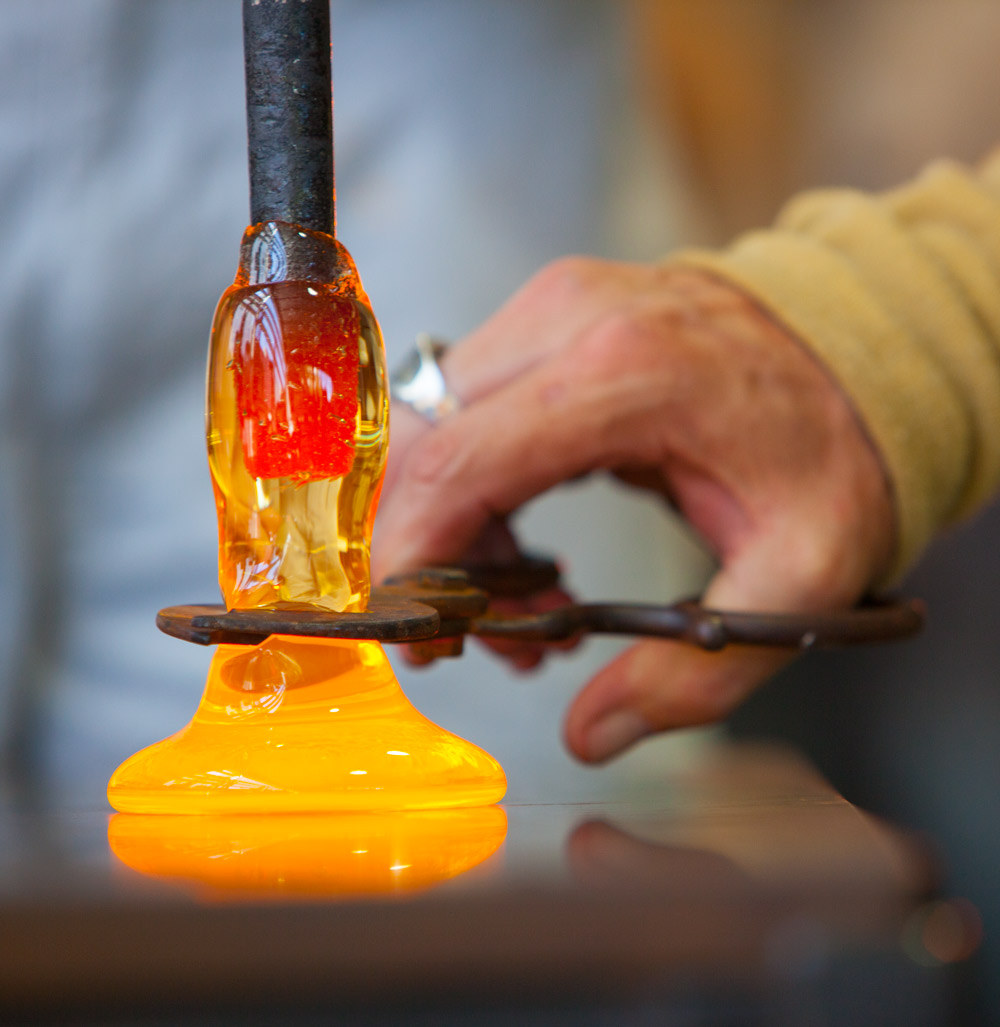
Photograph courtesy of the City of St. Petersburg
Almost immediately after it was incorporated in 1903 and named for the Russian birthplace of one of its founders, St. Petersburg attracted artists. They came to make sculptures and paintings for wealthy patrons who migrated south during the cold Northeastern winters. The city’s first true arts destination—the Florida Winter School—opened in 1916. A year later, an art club, now known as the Morean Arts Center, became the first art gallery south of Atlanta. A music club followed in 1922, which eventually morphed into the Florida Orchestra.
“Even back in those early days when there were just 10,000 people, art was significant,” says Wayne Atherholt, director of cultural affairs for the City of St. Petersburg. “It’s part of the city’s DNA.”
In 1965, the city got its first fine arts museum, erected on a stretch of downtown beachfront and bordered by hulking banyan trees. For the first time, St. Petersburg residents had access to exhibitions of works by world-caliber artists such as Rembrandt and American portraitist Samuel Lovett Waldo. The Salvador Dali museum opened in 1982, built after an enterprising local attorney saw a news article about a Cleveland couple looking to donate their expansive Dali collection. He and other influential residents convinced the pair the works should live in St. Petersburg.
Then, like many other urban areas across America, the city began to decline. By the early 1990s, there was very little in downtown St. Petersburg “except crime and a few elderly people,” Atherholt says. “We had a history museum, the Museum of Fine Arts, the Dali Museum. But the area surrounding them was awful.”
A turning point came in 1997, when the Florida International Museum at St. Petersburg College, which had opened in a defunct department store downtown, hosted a Titanic-themed exhibit that drew more than 800,000 visitors in six months. “That transformed downtown during the period when it was open,” Atherholt says. “There had been talk about the urban revitalization of St. Pete, but when people saw lines around the block for this exhibit, they started to become convinced.”
Developers and civic leaders recognized the value the arts could bring to the city’s tourism-driven economy. “There’s a real collaborative spirit here, not only between artists, but between the artistic community and the greater community,” Collins says. “I wouldn’t say there was a master plan to build up the arts scene, but the city understood that a rising tide lifts all boats and worked to embrace what was happening.”
In the late 1990s, St. Petersburg introduced ArtWalk, a monthly evening when galleries and art studios open their doors and premiere new works. In the early years, it spanned just five or six blocks; today, a trolley ferries visitors between more than forty galleries spread across five arts districts.

Photograph courtesy of the City of St. Petersburg
In 2012, the first mural appeared on the 600 block of the Central Arts District. A tribute to local artist Bill Correira, who had recently passed away, it propelled a wave of public murals down the length of the block and beyond.
Instead of fighting the street art (which the property owners condoned and sometimes requested), the city agreed to spotlight it. It sponsors the SHINE mural festival, an annual two-week event during which a small army of local and international street artists converge on the city, using its buildings as canvases.
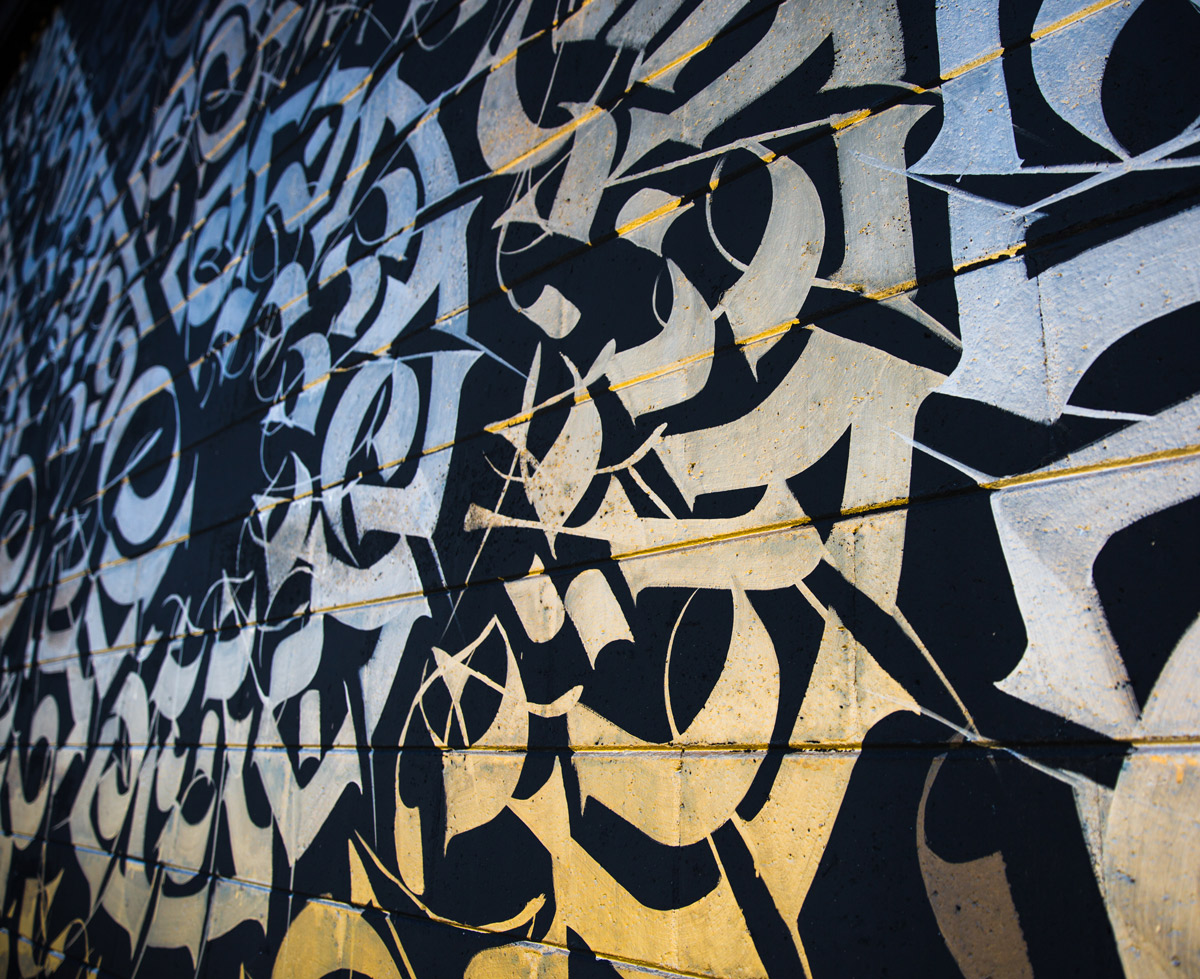
Photograph courtesy of the City of St. Petersburg
“We’ve done about fifty murals through SHINE, but that only represents a small fraction of what’s here,” says Collins, a SHINE sponsor. “We think there are more than 500 murals in St. Petersburg, with more going up all the time.”
Recently, the city’s leaders have stepped in to help prevent artists from being pushed out by the gentrification they helped propagate. The Warehouse Arts District Association began a campaign to protect affordable work space for local artists; the first phase of the project, called the ArtsXchange, saw the purchase of six warehouses devoted to studios, galleries, classrooms, and performance space. Fridays and Saturdays, the public is invited to wander the warehouses and watch artists at work.
“Art has become integral to everything we do here,” says Duncan McClellan, a prominent glass artist whose gallery has grown into the largest of its kind in the Southeast. “The arts scene has transformed the city on a large scale, but it’s also transformed individual neighborhoods, businesses, and lives, including my own.”
“When we first saw this place, it was a total wreck,” says Khris Johnson, head brewer at Green Bench Brewing, located a few blocks north of downtown’s Central Arts District. “Boarded windows, weeds waist-high, nobody on the street. But we saw the potential.”
That was back in 2013, when Johnson, who grew up in St. Petersburg, co-founded Green Bench—the city’s first microbrewery, named for the city’s old-timey benches. On a Friday afternoon five years later, the place is packed, part of the thriving local economy that has emerged in the wake of the city’s revitalization. Pop open a can of Green Bench’s bestselling Sunshine City IPA, and you’ll see a local artist’s work featured on the label. Grab a seat in their outdoor beer garden, and find oil paintings hanging on the brick walls. Like many local businesses, Green Bench isn’t merely a byproduct of the arts scene—it’s part of it.

Photograph courtesy of the City of St. Petersburg
“You can discover art in dive bars or street markets or pop-up shops,” Atherholt says. “You don’t have to be buzzed into a gallery with white walls.”
St. Petersburg is also a place where visitors can easily interact with local artists and see them work in their element. “You’re not so far removed from the artistic process,” says Michael Killoren, director of the Morean Arts Center. At the Morean’s Hot Shop, watch as jewel-toned glass is pulled like taffy and you’ll have a much greater appreciation for the intricate, fragile works on display in the Chihuly Collection across the street. (You can also find artists turning blocks of glass into curvilinear sculptures at Zen Glass Studio and Duncan McClellan Gallery.) At Charlie Parker Pottery or the Morean Center for Clay, pop into the back rooms to watch pottery being thrown and fired. And over at Funktion House, make an appointment to observe craftspeople create one-of-a-kind tables and desks out of trees that would otherwise be headed to landfills.
Jones of Studio@620 says he’s hopeful that St. Petersburg’s rise as a burgeoning arts capital is only just beginning. From its major museums to its tiny galleries, its warehouses filled with working artists to its bars where those artists relax after hours, there’s a creative crackle in the air. “It’s a unique ecology,” he says. “I like to think that there’s something in the dirt—the land on which we stand. It’s a little bit like magic dust.”
Where to See Art in the Sunshine City
Morean Arts Center
The Morean celebrated its centennial in 2017, and its contemporary gallery downtown is one of the oldest in the region. A few blocks away, the Morean Center for Clay houses gallery and studio space for ceramic artists. moreanartscenter.org

Photograph courtesy of the City of St. Petersburg
Chihuly Collection
The world’s most famous glass artist may be synonymous with the Pacific Northwest, but his permanent collection—including the glass garden Mille Fiori, Italian for “thousand flowers”—is here, presented by the Morean Arts Center. moreanartscenter.org/chihuly
Dali Museum
In 2011, this museum’s collection moved to an undulating geodesic building, designed by one of the architects who helped create the Louvre’s famous glass pyramid. Inside, ponder 2,000 of the surrealist’s works, including several of his famous melting clocks. thedali.org

Photograph courtesy of the City of St. Petersburg
Museum of Fine Art
Still housed in its original Palladian-style building on Beach Drive, this museum is home to several significant eighteenth- and nineteenth-century paintings (including works by female painters Elisabeth Vigee-Lebrun and Berthe Morisot) and the Southeast’s largest photography collection. mfastpete.org
Articles Gallery
Run by Leslie Curran, a lifelong resident, artist, and former city council member, this gallery exhibits a diverse array of works (banyan wood sculptures, nature prints, colorful abstract paintings) by emerging and mid-career local artists. articlesstpete.com
Florida CraftArt
Explore fine crafts—from blown-glass ornaments to statement jewelry to handcrafted furniture—made by artists throughout the state at this nonprofit gallery. There are great finds at every price point, so it’s also an ideal place to pick up a souvenir. floridacraftart.org

Photograph courtesy of Duncan McClellan Gallery
Studio@620
The motto of this community arts space is “the answer is always yes.” It hosts an eclectic, multidisciplinary mix of events, including dance shows, film screenings, and literary readings. thestudioat620.org
St. Pete Cultural Tours
These two-hour guided walking tours of the city’s world-class murals are led by local artists, and the proceeds help benefit public art and arts education. spculturaltours.com
Duncan McClellan Gallery
See works by more than fifty prominent glass artists, including McClellan himself, spread across spacious gallery rooms and a verdant sculpture garden. dmglass.com
More to Explore
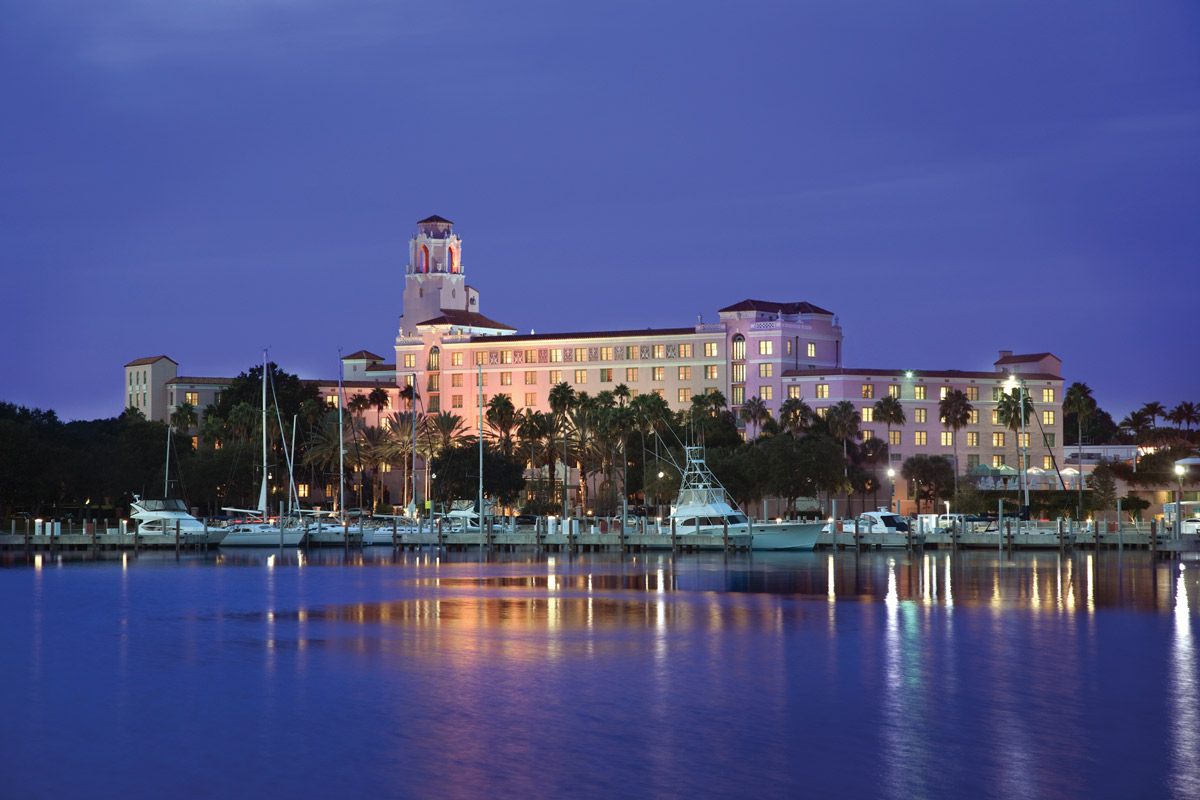
Photograph courtesy of Vinoy Resort & Golf Club
Stay
Built in 1925, the pink art-deco Vinoy Resort & Golf Club, now managed by Marriott, is nearing the completion of a two-year, $50 million renovation. The palatial, harbor-front property boasts a private marina, full-service spa, golf course, and two pools. It’s also within easy walking distance of the Museum of Fine Arts, the Dali Museum, and many galleries.
Every room is different at Postcard Inn on the Beach, a refurbished circa-1957 motor inn with a surf-chic aesthetic, located just a few miles southwest of downtown on the postcard-perfect sands of St. Pete Beach.
Eat & Drink
Banyan Cafe is a neighborhood hangout serving locally roasted coffee and breakfast sandwiches. Try the smoked salmon bowl, a breakfast twist on trendy poke bowls.
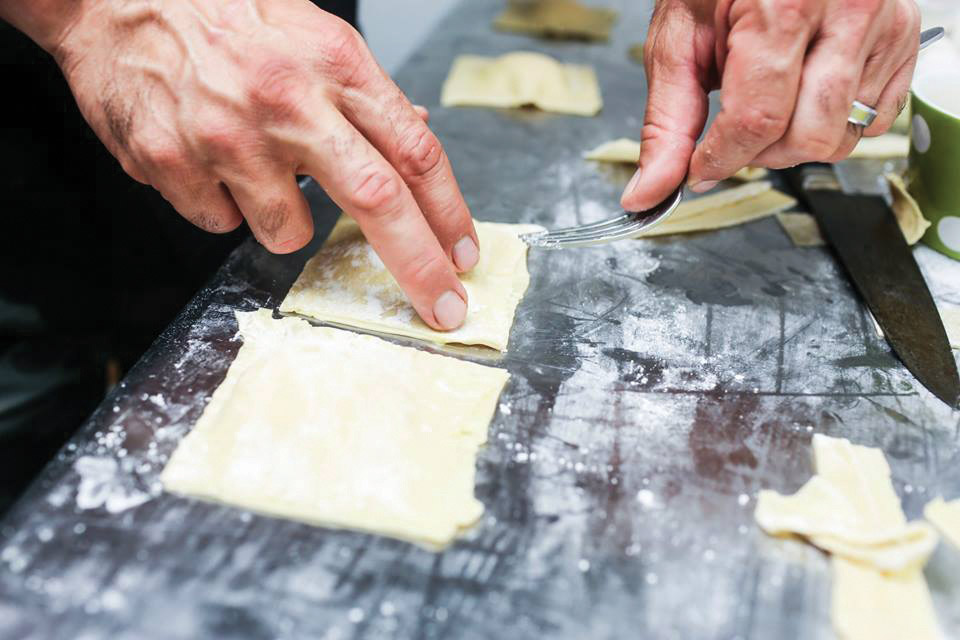
Photograph courtesy of Brick & Mortar
For lunch, Bodega On Central offers Cuban sandwiches, fresh-made soda fresca, and plenty of vegetarian and vegan choices. Browse the offerings at Locale Market, a 20,000-square-foot food hall and gourmet market, or grab a seat upstairs at FarmTable Cucina, which serves the best of the market’s bounty. For an indulgent weekend brunch, try The Mill, a rustic restaurant serving crisp apple fritters, gooey banana bread french toast, and shrimp over pimento cheese grits.
It’s hard to choose from the expansive dinner menu at rustic Brick & Mortar, but top-sellers include the freshly made pasta and the juicy B&M Burger served on a pretzel bun. Zip across the street to Cycle Brewing for a pint of Rickshaw Double IPA afterwards.
For intimate ambiance and killer cocktails, grab a table at Ichicoro Ane, a new St. Pete outpost of the wildly popular Tampa ramen bar. If you’re feeling adventurous, end the meal with halo-halo, a traditional Filipino shaved ice dessert. You’ll also find inventive drinks at Intermezzo, a coffee shop by day and craft cocktail bar by night.

Photograph courtesy of St. Pete Shuffleboard Club
Do
Friday nights are open courts (and BYOB!) at the normally members-only St. Pete Shuffleboard Club. Located alongside downtown’s Mirror Lake, it’s the largest and oldest shuffleboard club in the world. Never played? Ask the volunteers, some of whom play on the competitive circuit, for pointers.
The next day, find avocados the size of your head, freshly made tamales, and local arts and crafts at the weekly outdoor Saturday Morning Market.
This article appears in our Spring/Summer 2018 issue of Southbound.














